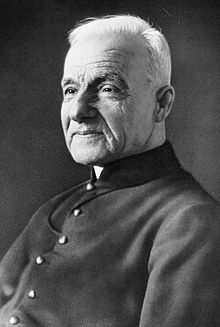Saint Joseph's Oratory
With its monumental scale, Renaissance Revival facade and contrasting Art Deco interior, the Oratory is recognizable not just in Montreal but around the world, attracting more than 2 million visitors and pilgrims to its steps each year.
[5] Since 2018, the dome and lantern atop the Oratory have undergone a series of renovations expected to be completed in 2024 by architecture firms Atelier TAG and Architecture49.
From 1914 to 1916, Viau and Venne constructed the crypt church, with seating for 1000, which still stands today and forms the base of the basilica where the massive collection of stairs ends.
Viau and Venne had wanted the dome of the Oratory to resemble that of St. Peter’s Basilica in Rome, and to be smaller than it actually is today; however, they never had the chance to see those plans through as construction was halted with the Great Depression.
From 1949 to 1951, architect Gilbert Moreau carried out alterations and improvements to the interior of Saint Joseph's Oratory, as well as to the adjacent monastery, and rearranged the sacristy in the basilica.
For RCA Victor he released the LP album Carols at the Carillon of Saint Joseph's Oratory for which he wrote the arrangements.
The 49¢ stamps are perforated kiss cut and were printed by Lowe-Martin Company Inc.[10] That same year, the Oratory was designated a National Historic Site of Canada.
[11][12] On October 30, 2007, Father Charles Corso, a priest at the Oratory, was faced with a disorganized and depressed man who threatened to kill himself with a handgun.
[13] On March 22, 2019, a 26-year-old man wearing a dark winter coat and light-coloured baseball cap entered the Oratory during the Friday morning mass, rapidly walked up to the centre, and stabbed the celebrating priest, Father Claude Grou.
"[13] Today, the basilica enshrines a venerated statue of Saint Joseph, currently located within the oil-burning chapel that was authorized a Canonical coronation by Pope Pius X on 19 March 1910 via Cardinal Vincenzo Vannutelli.
The same image was ceremonially crowned for the second time on 9 August 1955 by Pope Pius XII via Cardinal Paul-Émile Léger.
The basilica, as it stands today, comprises many parts, including the Crypt Church, located underneath the basilica, the Votive Chapel, between the Crypt and the rock of Mount-Royal, the Shrine, which encompasses the nave, apse and transept, and the dome, which is the largest church dome in Canada and the third largest in the world.
The main aisle inside the basilica, and even the cross on the altar, are also in perfect alignment with the setting sun on the longest day of the year.
[3] There is a statue of Joseph made out of Carrara marble behind the main altar of the Crypt Church, added in 1917 by the Italian artist A. Giacomini.
Eight stained glass windows depicting the stages in Saint Joseph's life were installed in the crypt in 1919 by the Montreal firm Perdriau et O'Shea.
The apse, as well as the rest of the interior, is designed in Art Deco style, which was very popular in Montreal during the 1930s, and contains sculptures, bas-reliefs, mosaics and stained glass of religious imagery.
Like the cathedral in Florence, the outer dome of the Oratory consists of eight pointed arches laying atop an octagonal drum, with a lantern and cross.
In 2018, the architectural firms Atelier TAG and Architecture49 won a competition organized by Saint Joseph's Oratory[17] to renovate the inside of its dome and its observatory.
The project is estimated to cost around $80 million CAD and will also include a complete renovation of the building's museum and the construction of a new welcome centre on Queen Mary road.






